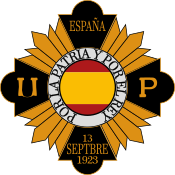| This article may be a rough translation from Spanish. It may have been generated, in whole or in part, by a computer or by a translator without dual proficiency. Please help to enhance the translation. The original article is under "español" in the "languages" list.
If you have just labeled this article as needing attention, please add {{subst:Needtrans|pg=Patriotic Union (Spain) |language=Spanish |comments= }} ~~~~to the bottom of the WP:PNTCU section on Misplaced Pages:Pages needing translation into English. (April 2023) |
| Patriotic Union Unión Patriótica | |
|---|---|
 | |
| Leader | Miguel Primo de Rivera |
| Founded | 14 April 1924 (14 April 1924) |
| Dissolved | 1930 |
| Succeeded by | National Monarchist Union |
| Headquarters | Madrid, Spain |
| Newspaper | La Nación |
| Ideology | Spanish nationalism Political Catholicism Monarchism Conservatism Corporatism |
| Political position | Right-wing |
| Part of a series on |
| Conservatism in Spain |
|---|
 |
| Ideologies |
| Principles |
| History |
| Intellectuals |
Literature
|
Politicians
|
| Commentators |
|
PartiesActive
Defunct |
| Organisations |
| Media |
| Related topics |
The Patriotic Union (Spanish: Unión Patriótica, UP) was the political party created by Spanish dictator Miguel Primo de Rivera, conceived as a support to his regime and integrating political Catholicism, technocrats, and the business-owning classes. The party's power was dependent upon the power of its founder and leader, not any popular mandate. Following the dismissal of Miguel Primo de Rivera in January 1930 by King Alfonso XIII, the party was succeeded by the National Monarchist Union.
Membership
There is no reliable information on membership figures. The party review Unión Patriótica claimed in 1927 that there were 1,319,428 people on the rolls; in 1928 the same source reported the figure as 1,696,304. Most historians consider these figures fairly meaningless and note that they probably reflect bureaucratic ingenuity rather than the scale of genuine recruitment. However, some scholars settle for official figures, e.g. in the province of Almería the UP membership is estimated at 30,000 and in mid-size Valencian towns like Gandia, Torrent or Utiel at 500–1,000 members.
An official yet not public note from Primo de Rivera, dated 1929, estimated membership at 600–700,000. Many historians tend to settle for even smaller figures, ranging from 400,000 to 500,000. These estimates are pretty much a guesswork, though some scholars base their calculations on circulation of the UP daily La Nación, at its peak printed in 50,000 copies.
Figures in the range of 1.3m–1.7m would suggest the membership rate of some 6–8% (compared to the entire population), figures in the range of 0.4–0.5m would point to some 2%. In comparison to other state parties, in the mid-1930s some 10% of the Italian population were on the rolls of PNF; in 1937 some 8% of Germans were members of NSDAP. The communist state parties of the late 20th century recorded a membership rate between 4% in the USSR to 8–10% in Poland or Czechoslovakia. FET y de las JONS, the state party during the Francoist dictatorship, boasted of some 0.9m members in 1942, around 3% of the Spanish population.
Notes
- Alejandro Quiroga, La llama de la pasión. La Unión Patriótica y la nacionalización de masas durante la dictadura de Primo de Rivera, Fernando Molina Aparicio (ed.), Extranjeros en el pasado. Nuevos historiadores de la España, Madrid 2009, ISBN 9788498602098, p. 261, James H. Rial, Revolution from Above: The Primo de Rivera Dictatorship in Spain, 1923–1930, London 1986, ISBN 9780913969014, p. 128
- Rose Martínez Segarra, La Unión Patriótica, Cuadernos constitucionales de la Cátedra Fadrique Furió Ceriol 1 (1992), p. 73, Quiroga 2009, p. 261
- see e.g. Shlomo Ben-Ami, El cirujano del hierro, Barcelona 2012, ISBN 9788490061619, pp. 134–135
- Pedro Martínez Gómez, La dictadura de Primo de Rivera en Almería (1923–1930). Entre el continuismo y la modernización, Almería 2007, ISBN 9788482408743, p. 323
- Julio López Iñíguez, La Unión Patriótica y el Somatén Valencianos (1923–1930), Valencia 2007, ISBN 9788491341284
- Quiroga 2009, p. 261
- J. L. Goméz Navarro, La U.P.: análisis de un partido en el poder, Estudios de Historia Social 32–34 (1955), p. 138
- “Scarcely a third of that ” Stanley G. Payne, Fascism in Spain, 1923–1977, Madison 1999, ISBN 9780299165642, p. 29
- Eduardo González Calleja, La España de Primo de Rivera. La modernización autoritaria 1923–1930, Madrid 2005, ISBN 8420647241, pp. 192–193
- some 4m out of 42m
- 5,4m out of 69m
- in 1957, Walter S. Hanchett, Some observations on membership figures of the Communist Party of the Soviet Union, The American Political Science Review 52 (1958), p. 1125
- William B. Simons, Stephen White, The Party Statutes of the Communist World, Hague 1984, ISBN 9789024729753, p. 327
- Jan Richter, Twenty-six years after the Velvet Revolution, Radio Praha 17.11.2005, available here
- Stanley G. Payne, The Franco Regime, 1936–1975, Madison 2011, ISBN 9780299110734, p. 176